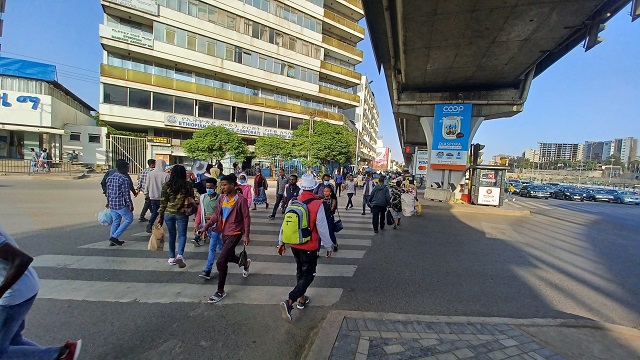
In Addis Ababa, road traffic crashes kill more than 400 people every year. This is largely due to unsafe street design that prioritizes vehicles over pedestrians, cyclists and other vulnerable road users. With the support of Bloomberg Philanthropies Initiative for Global Road Safety (BIGRS), WRI has been helping the city redesign its streets to improve safety and accessibility, particularly for vulnerable road users. Such improvements are also fundamental to encouraging active, low-emission mobility and to fostering an environment of steady foot and cycling traffic that is conducive for local businesses.
After conducting several road safety inspections across the city, WRI found that Bole Road, a 4.4 km-length thoroughfare that links the airport with the city center, was one of the most high-risk corridors. In 2015, the team began working with the city to identify problems and implement design changes for a safer, more accessible and more efficient road.
Bole Road has four wide lanes in each direction. It runs through developed areas where safe accessibility for pedestrians and other users is important not only for their mobility but for local businesses and economic activity.
Before WRI’s intervention, Bole Road had a roundabout and signal-controlled intersection at both ends but no traffic stoppages in between (two grade-separated roundabouts and one overpass bridge serve the crossing and turning traffic). Despite the lack of intersections, this stretch still had 31 at-grade pedestrian crossings. High-traffic congestion frequently occurred at the grade-separated roundabouts above the road and at the two ends. In the first year of its opening to traffic in 2013, the road registered 10 deaths, 55 severe injuries, 131 minor injuries and 1,419 property damages due to road traffic crashes.
Dangerous Crossings
Since Bole Road is in a developed area, many pedestrians need to cross the road at any given time. During peak hours, WRI found that more than 500 pedestrians were crossing the road at 15 of the 31 crossings. Among these, four crossings served more than 1,000 pedestrians during peak hours.
These crossings were extremely dangerous. Pedestrians had to navigate across four lanes of uninterrupted, high-speed traffic to reach a narrow median – a total of almost 30 meters (98 feet) – without conflict control like pedestrian crosswalk signals or signs. Pedestrians should never cross more than two lanes of traffic without some kind of conflict control mechanism.
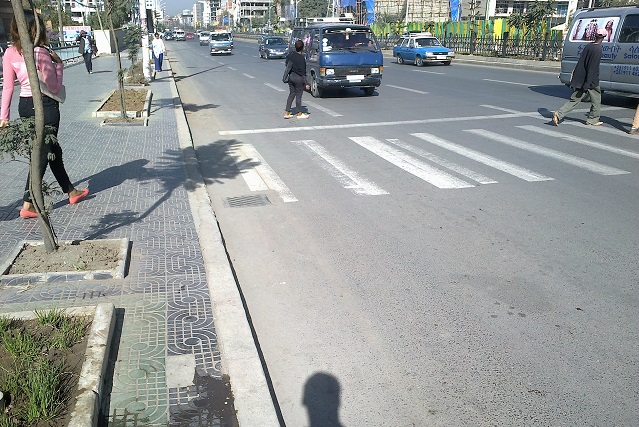
High Speeds
At the time of inspection, WRI measured the average speed of traffic up to 48 kph during midday. Local crash data showed that the lack of giving priority to pedestrians was cited in 43% of serious injury cases registered by authorities. Data also showed that crashes between vehicles were concentrated at junctions and U-turns, a result of drivers encountering vehicles that were joining or turning on the road at uncontrollable speeds.
The design of the road – wide carriageways and lanes and grade separation of crossing roads – encouraged higher speeds, and the 60-kph speed limit was not enforced. Asking pedestrians to cross this kind of road without proper safety measures was essentially a death trap.
Inaccessibility and Network Inefficiency
The limited availability of safe access points for both pedestrians and vehicles on Bole Road affected both residents and businesses. Most of the surrounding roads in the area were underutilized due to lack of connectivity. Drivers stayed in long lines just to cross Bole Road or to make a U-turn.
Efforts made to accommodate turning and crossing demands with U-turns also affected the efficiency of the road. To make a U-turn, drivers had to occupy one lane of the carriageway from which they were turning and disrupt traffic on two more lanes when coming into the other carriageway because of the narrow median.
A road developed for efficient movement of vehicles was providing service equivalent to a two-lane double carriageway road: two lanes taken for U-turns and one lane for public transport stops, leaving only one lane available for uninterrupted mobility. Many buses and paratransit vehicles operate on the road, and more than half the city relies on these services for their daily trips, according to a survey done by the city. But accessing this public transport was dangerous for pedestrians. Crossing the road to catch a bus or to reach a final destination after arriving at a stop carried very high risk. The lack of designated stops along the road also meant that vehicles often halted abruptly to pick up or drop off passengers, further contributing to the road’s inefficiency.
Bole Road’s Transformation
To address these issues, the city made key design improvements to Bole Road based on WRI’s analysis and recommendations:
Pedestrian Signals
Improving pedestrian safety required solutions that calmed traffic speeds as well as allowed pedestrians to make safe crossings. Pedestrian signals have been provided at three mid-block crossings to call for red lights based on the availability of pedestrians detected through the touch button. This allows pedestrians to cross safely and vehicular traffic to continue uninterrupted when pedestrians do not need to cross.
The pedestrian signals at these crossings also help people trying to cross at other locations along Bole Road where pedestrian signals are not provided, as the temporary stopping of vehicles at the signals creates pauses in traffic and helps calm overall vehicle speeds.
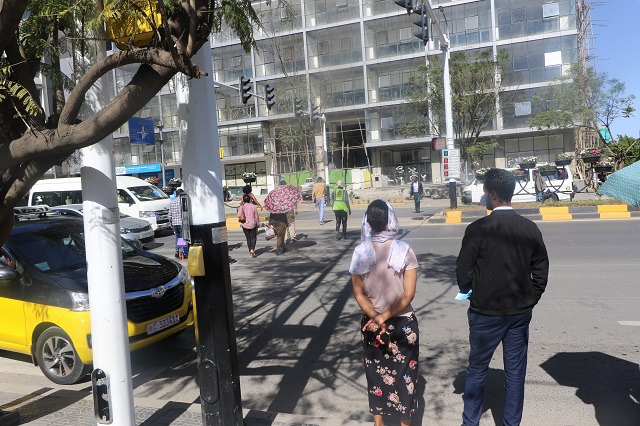
Staggered Crossings
At the remaining mid-block crossings without pedestrian signals, staggered crossings have been provided. Fences on the median force pedestrians to change their crossing path so that they face the approaching traffic and see when it is safe to cross. Staggered crossings also provide more waiting space in the median if pedestrians are unable to cross in a single phase.
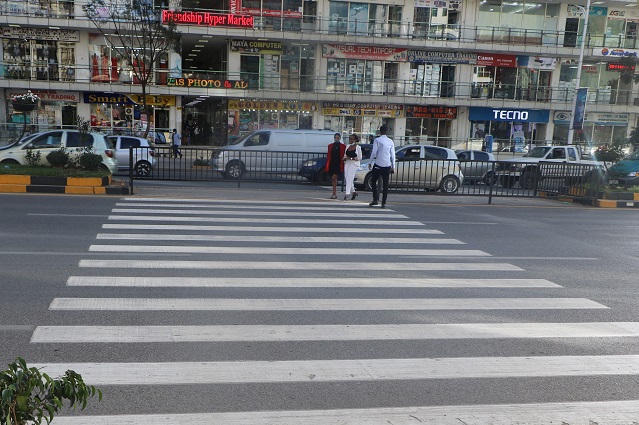
Signaled Intersections
Four new signaled intersections have also been opened. Pedestrians are able to cross safely when green signals are provided and additional intersections mean shorter distances between stoppages, which helps calm vehicle speeds. (Evidence shows that the longer the distance between intersections, the higher vehicle speeds are likely to be.)
The new intersections also improve general connectivity in the area and the efficiency of the road network, as they were opened in locations that align with other local roads. U-turn locations have been reduced to two that are operating in coordination with the signaled intersections.
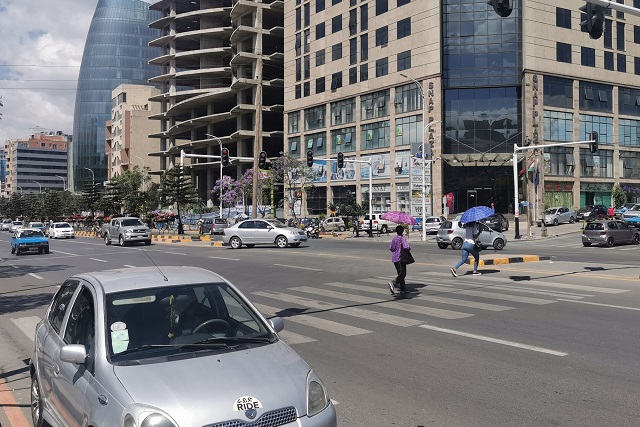
Improved Intersections
The existing Estifanos and St. Joseph intersections at one end of Bole Road have been made safer and more efficient. Pedestrian signals and new crosswalk design features, such as cut-throughs that allow pedestrians to walk at-grade to the carriageway when crossing medians and refuge islands, have been added. Ramps now help transition from walkways to the carriageways, which improves accessibility for residents. Clear paths and pedestrian crossing paints help show pedestrians where it’s safe to cross. Refuge islands provide space to wait before crossing the second carriageway. Tactile information is also provided for visually impaired pedestrians. The overall reduced carriageway space, as a result of reclaimed space for pedestrians, also helps reduce vehicle speeds.
Observed Improvement
These improvements have helped transform Bole Road from dangerous and confusing into a space that is both safer and more functional for all users and the surrounding area.
A preliminary comparison of 11 months of fatal crash data from the city showed that fatal crashes were reduced 56%. Surrounding roads have become more active and are serving traffic, leading to more effective utilization of available infrastructure. The fact that both pedestrians and drivers can more easily move along and across the road now has also benefited local businesses. Consistent with the change in the road’s primary function, the city reduced the speed limit on the road from 60 kph to 50, though enforcement remains a challenge.
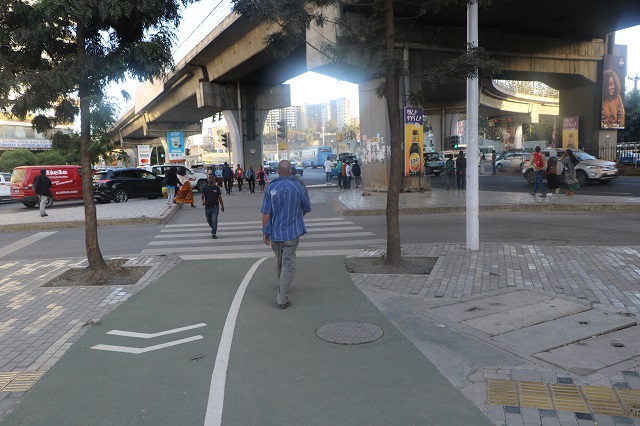
The Bole Road improvement is an example of a people-oriented intervention with multiple objectives that, given its success, may now drive future action in Addis Ababa and beyond. There remains work to be done, including additions like tactile surfaces at more crossings and audio at pedestrian signals, along with stricter enforcement of new measures. Monitoring and evaluation of the corridor should continue to determine the effectiveness of the interventions as well as to quickly understand new traffic patterns. This is only the first step towards eliminating all road traffic deaths and injuries on the road.
Jiregna Hirpa is a Transport Planner at WRI Africa.
Iman Abubaker is Urban Mobility Project Manager for WRI Africa, based in Addis Ababa.
Celal Tolga Imamoglu is Senior Manager for Transport & Road Safety at WRI Turkey Sustainable Cities.






